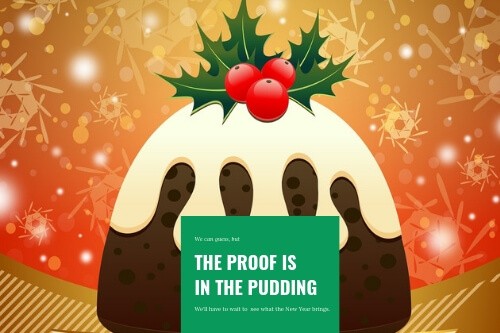
YouTube / iTunes / Spotify / Radio Public / Pocket Casts / Google Podcasts / Breaker / Overcast
Listen to ArtisanEnglish.jp posts & lesson intros here.
Proverb: The proof is in the pudding
Will 2019, the year of the boar, be a good year? Who can tell for sure? The only guarantee is the proof is in the pudding.
By this time next week, Christmas Day will have come and gone.
We’ll all be thinking about the fast-approaching New Year, which will be the last of the Heisei Era in Japan.
Perhaps, it hasn’t all been eaten.
You may still have some Christmas pudding leftover in the fridge.
Do you like Christmas pudding?
I don’t.
The proof is in the pudding means to understand what something is truly like, you have to try it first.
Christmas pudding is a traditional sweet made with assorted dried fruits such as raisins, currants and oranges mixed with suet (hard beef fat), a little flour, some bread crumbs and molasses.
Oh, and don’t forget the brandy!
It’s a traditional British dessert served during the Christmas season.
It’s also where the expression the proof is in the pudding originates.
Pudding in Britain and where I come from, Newfoundland, can mean two things.
One is a sweet dessert, and the other is a sausage.
It’s common for people back home to make bread pudding, for example, or to buy blood/black pudding (a sausage made with pig blood) from the grocery store.
With both types of food, you never know what’s in it until you eat it.
That’s why the proof is in the pudding means you have to try it first to understand what something is truly like.
The proverb has morphed or changed over time.
Originally it was ‘the proof of the pudding is in the eating.’ This slowly evolved to ‘the proof of the pudding,’ which morphed again to become the currently used the proof is in the pudding.
In Japan, many people purchase Christmas cakes.
Authentic Christmas cake is rather a gorgeous fruitcake.
It’s similar to Christmas pudding, but Christmas cake contains butter, flour, and icing, whereas Christmas pudding has less flour and is made with fat.
Flesch-Kincaid Readability Test
This post is understandable by someone with at least a 7th-grade education (age 12).
On the Flesch-Kincaid reading-ease test, this post scores 79.
The easier a passage is to read, the higher the score on a scale of 0 – 100.

